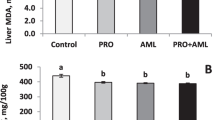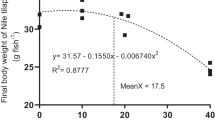Abstract
The objective of this study was to investigate the influence of microbial phytase and calcium supplementation to diets for growing pigs on the retention of lead in the kidney, liver, muscle, brain, and bone (phalanx 1). The experiments were carried out with barrows over the body weight range from 17 to 50 kg. The average lead concentration of the diets was 1.45 mg/kg dry matter. Diets were prepared with or without a supplement of 800 units of microbial phytase. The calcium concentration in the diets was 6.53 or 13.4 g/kg dry matter. The addition of microbial phytase showed an increase of lead concentration in bone. By increasing the calcium concentration to 13.4 g/kg dry matter, it was possible to avoid the phytase-induced increase of lead retention in bone.
Similar content being viewed by others
References
J. Pallauf, G. Rimbach, et al., Dietary effect of phytogenic phytase and an addition of microbial phytase to a diet based on field beans, wheat, peas and barley on the uti- lization of phosphorus, calcium, magnesium, zinc and protein in piglets, Z.ErnÄhrungsw. 33, 128–135 (1994).
J. Pallauf, G. Rimbach, et al., Effect of phytase supplementation to a phytate-rich diet based on wheat, barley and soya on the bioavailability of dietary phosphorus, cal- cium, magnesium, zinc and protein in piglets,Agribiol. Res. 47, 39–48 (1994).
A. Pointillart, Enhancement of phosphorus utilization in growing pigs fed phytate- rich diets by using rye bran,J. Anim. Sci. 69, 1109–1115 (1991).
L. Young, M. Leunissen, and J. Atkinson, Addition of microbial phytase to diets of young pigs,J. Anim. Sci. 71, 2147–2150 (1993).
X. G. Lei, P. K. Ku, et al., Supplemental microbial phytase improves bioavailability of dietary zinc to weanling pigs,J. Nutr. 123, 1117–1123 (1993).
D. Farrell, E. Martin, et al., The beneficial effects of a microbial feed phytase in diets of broiler chickens and ducklings,J. Anim. Physiol. Anim. Nutr. 69, 278–283 (1993).
H. Edwards, Dietary 1,25 Dihydroxycholecalciferol supplementation increases nat- ural phytate phosphorus utilization in chickens,J. Nutr. 123, 567–577 (1993).
P. C. Simons, H. A. J. Versteegh, et al., Improvement of phosphorus availability by microbial phytase in broilers and pigs,Br. J. Nutr. 64, 525–540 (1990).
S. Sebastian, S. P. Touchburn, et al., The effects of supplemental microbial phytase on the performance and utilization of dietary calcium, phosphorus, copper, and zinc in broiler-chickens fed corn-soybean diets,Poult. Sci. 75, 729–736 (1996).
H. J. Lantzsch, Studies on nutritional effects of phytate in monogastric animals (rat, pig),übers. TierernÄhrung 18, 197–211 (1990).
G. Rimbach and J. Pallauf, Effect of an addition of microbial phytase on zinc- availability, Z.ErnÄhrungsw. 31, 269–277 (1992).
M. Düngelhoef and M. Rodehutscord, Wirkung von Phytasen auf die Verdaulichkeit des Phosphors beim Schwein,übers. TierernÄhrung 23, 133–157 (1995).
A. Wise and D. J. Gilburt, Binding of cadmium and lead to the calcium-phytate com- plex in vitro,Toxicol. Lett. 9, 45–50 (1981).
E. Schulz and H. J. Oslage, Untersuchungen zur intestinalen Hydrolyse von Inosit- phosphorsÄureester und zur Absorption von Phytinphosphor beim Schwein. 2. Mit- teilung: Untersuchungen zur Hydrolyse der InositphosphorsÄureester im Verdauungstrakt des Schweines,J. Anim. Physiol. Anim. Nutr. 30, 76–91 (1972).
A. Sandberg, T. Larsen, and B. Sandstrom, High dietary calcium level decreases colonic phytate degradation in pigs fed a rapeseed diet,J. Nutr. 123, 559–566 (1993).
H. J. Lantzsch, S. Wjst, and W. Drochner, The effect of dietary calcium on the efficacy of microbial phytase in rations for growing pigs,J. Anim. Physiol. Anim. Nutr. 73, 19–26 (1995).
National Research Council,Nutrient Requirements of Domestic Animals, National Acad- emy Press, Washington, DC, pp. 1–93 (1988).
W. OelschlÄger, W. Huss, and L. Bestenlehner, Untersuchungen über Bleigehalte in Futtermitteln,Landw. Forschung 27, 272–280 (1974).
G. Crössmann, Schwermetalle in handeis- und wirtschaftseigenen Futtermitteln,Berich. Landwirtsch. 55, 785–795 (1977).
Bundesministerium für ErnÄhrung, Landwirtschaft und Forsten,Futtermittelverord- nung, (1992), Bundesgesetzblatt No.53, November21, 1992, p. 1898.
F. Hsu, L. Krook, et al., Interactions of dietary calcium with toxic levels of lead and zinc in pigs,J. Nutr. 105, 112–118 (1975).
K. B. Nolan, P. A. Duffin, and D. J. McWeeny, Effects of phytate on mineral bioavail- ability. In vitro studies of Mg2+, Ca2+, Fe3+, Cu2+ and Zn2+ (also Cd2+) solubilities in the presence of phytate,J. Sci. Food Agric. 40, 79–85 (1987).
W. J. Evans and C. J. Martin, Interactions of inositol hexaphosphate with Pb(II) and Be(II)—a calorimetric study. XVIII,J. Inorg. Biochem. 45, 105–113 (1992).
J. I. Bullock, P. A. Duffin, et al., Effect of phytate on the in-vitro solubility of Al3+, Ca2+, Hg2+ and Pb2+ as a function of pH at 37 degrees C,J. Sci. Food Agric. 67, 507–509 (1995).
C. Valiente, E. Molla, et al., Cadmium binding capacity of cocoa and isolated total dietary fibre under physiological pH conditions,J. Sci. Food Agric. 72, 476–482 (1996).
A. Wise, Protective action of calcium phytate against acute lead toxicity in mice,Bull. Environ. Contamin. Toxicol. 27, 630–633 (1981).
A. Wise, Blood lead levels after chronic feeding to mice of lead acetate with calcium phytate in the diet,Bull. Environ. Contamin. Toxicol. 29, 550–553 (1982).
H. E. Rose and J. Quarterman, Effects of dietary phytic acid on lead and cadmium uptake and depletion in rats,Environ. Res. 35, 482–489 (1984).
H. E. Rose and J. Quarterman.Influence of Dietary Phytic Acid and Calcium on Lead Retention in the Rat, Proc. 5th Int. Symposium on Trace Elem. in Man and Anim., ed. Mills, C. F., Bremner I. and J. K. Chesters, p.170, (1984).
H. Schenkel,Zur Rolle des Calciums als Inhibitor bei höheren Schadstoffbelastungen, Forschungsbericht No. 538031, Deutsche Landwirtschaftsgesellschaft Frankfurt, pp. 1–46 (1988).
D. Oberleas, M. E. Muhrer, and B. L. O’Dell, Dietary metal-complexing agents and zinc availability in the rat,J. Nutr. 90, 56–62 (1966).
Author information
Authors and Affiliations
Rights and permissions
About this article
Cite this article
Zacharias, B., Lantzsch, H.J. & Drochner, W. Influence of microbial phytase and dietary calcium on the accumulation of lead in different organs of pigs. Biol Trace Elem Res 70, 243–249 (1999). https://doi.org/10.1007/BF02783833
Received:
Revised:
Accepted:
Issue Date:
DOI: https://doi.org/10.1007/BF02783833




